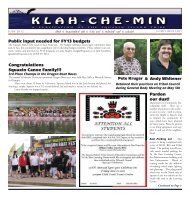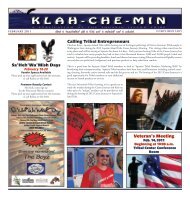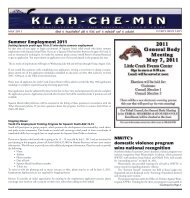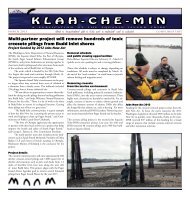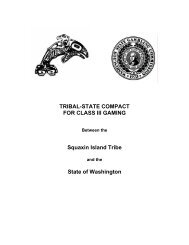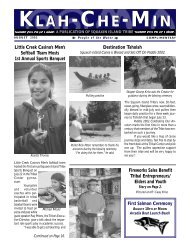Canoe Journey Guidebook - Squaxin Island Tribe
Canoe Journey Guidebook - Squaxin Island Tribe
Canoe Journey Guidebook - Squaxin Island Tribe
You also want an ePaper? Increase the reach of your titles
YUMPU automatically turns print PDFs into web optimized ePapers that Google loves.
Make T-shirts with your Tribal <strong>Journey</strong> logo with large<br />
lettering for volunteers and security and staff.<br />
Look at tide charts and determine appropriate landing<br />
times (canoes almost always land later than planned).<br />
Know prevailing winds and currents.<br />
Communicate—to ensure information is made available<br />
to people who can’t attend meetings. Meetings occur all<br />
over, so there needs to be greater coordination between<br />
North & South tribal communities. Someone should put<br />
together a poster about the <strong>Journey</strong> to distribute to all<br />
tribes, so those not involved will know what is happening.<br />
Keep a bulletin board with protocol schedules and<br />
updates. Often on a journey of this kind, information<br />
is passed by word of mouth and it misses people or is<br />
garbled in transmission. Try to ensure as many regions as<br />
possible receive all notifications and updates.<br />
In the past, there have been problems with host communities<br />
not fully guiding canoes into their land. Address this in<br />
our canoe families. BEFORE canoes get to the host tribe’s<br />
landing, provide <strong>Canoe</strong> Families with good charts, tide information,<br />
locations of sandbars, maps and a comprehensive<br />
map designating where we’re landing, where support<br />
boats will be moored & where the rest areas are. Provide a<br />
boat stationed near landings to help guide canoes in.<br />
Host communities can provide information on what route<br />
is best and safest and what should expected -- tides,<br />
weather, conditions, etc. Get local advice from each area.<br />
For <strong>Canoe</strong> Families on the Water<br />
• Notify the Coast Guard (or Seattle Traffic) when out on<br />
the water so that there are no accidents (with freighters,<br />
ferries), especially when approaching traffic lanes<br />
and passing traffic lanes, preferably on VHF.<br />
• It is usually safer for all to travel on the same route<br />
in groups that go similar speeds. The canoes that<br />
go more slowly should stick together. The canoes<br />
that go more quickly should stick together to avoid<br />
being too spread out on the water. Get through areas<br />
of potential danger, like traffic areas and narrow<br />
channels quickly. Slower canoes should set out<br />
earlier and faster canoes later to help us arrive closer<br />
together and reduce waiting time at the landing.<br />
• We are always in need of additional support boats.<br />
Good communication is needed on the water (VHF<br />
radios on the same channel and predetermined hand<br />
signals). Know the routes and tides and information<br />
about the currents. In the past, we’ve spread out too<br />
far to be safe.<br />
Safety<br />
Cold-Water Safety<br />
Everyone is encouraged to go through cold water trainings—even<br />
more than once. The more exposure to cold<br />
water, the better, even if it means sitting in cold bath water<br />
or taking cold showers. (For information about preventing<br />
hypothermia see Cold-Water Safety Training section).<br />
Safety Equipment & Devices<br />
• GPS software can identify moorage docks, gas stations,<br />
etc. along the way. Know how to use it!<br />
• The more fishermen and fisherwomen that you have<br />
on your crew, the better. You need people with knowledge<br />
the water environment.<br />
• It is recommended to go over your equipment list in<br />
the weeks before the journey—make a checklist, and<br />
go through each item, making sure it is accounted for<br />
and everyone knows where it is.<br />
• Look at each leg of the journey as a journey in itself—<br />
be prepared for each journey with gear and experience.<br />
Some skippers require that each crew member<br />
carry at least a quart of water; emergency lunch;<br />
dry clothes in waterproof bag; sunglasses; sun hat;<br />
sunscreen. Many crews keep such things on a support<br />
boat, but sometimes support boats are called away to<br />
transport or on an emergency. Or you may pull with<br />
a different canoe and get separated from your gear<br />
on the support boat. When this happens you can get<br />
thirsty, sunburned, hungry, and cold. Plan on being<br />
out 18 hours with only what you are carrying on<br />
board.<br />
Capsizing<br />
Practice time can be allotted for doing roll-overs. It’s<br />
important to practice with only the minimum number of<br />
people needed to right the canoe (for some canoes this is<br />
two, for some four). You have to have at least one person<br />
who knows how to right-it to direct the others.<br />
Weather<br />
• Guard against the weather and cold temperatures—it<br />
gets very cold—be aware of what to bring in terms of<br />
clothes and gear. Think about weather conditions and<br />
BE PREPARED.<br />
• Plan to be out for a longer period than you expect.<br />
Plan for all weather. Bring extra supplies in canoes in<br />
case you become separated from a support-boat.<br />
• In some areas calm, warm sunny mornings may turn<br />
into windy, choppy, cool afternoons. Wind alone has<br />
caused hypothermia to those in support boats.<br />
Fitness<br />
• There should be preparation in activity to get more<br />
flexible and fit for the event.<br />
29 • paddle to squaxin 2012





